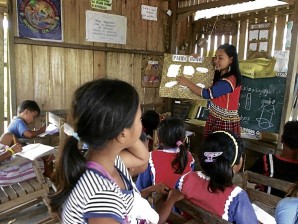Educating ‘lumad’ the ‘lumad’ way
Reflecting on his upcoming graduation, a teenage Dibabawun student recalls going to class with an empty stomach as his most difficult time in school.
“I was really very hungry,” said Angelito Cotao, 16. “There was nothing to eat, and there was nothing I could do about it, that was my most difficult time.”
Too shy even to face his classmates, Cotao turned his back and hunched over his seat as he talked.
But what he said was quickly understood by his teacher and classmates in this Dibabawun community in the hinterland sitio of Calinogan in Barangay Casoon, one of the communities still recovering from Typhoon “Pablo.”
Even before Pablo, life in the village was already difficult. People mostly depended on farming to earn, the crops that they grow consisting mainly of coconut, banana and corn.
3-km walk
Their products are sold cheap in the market. The village is so remote that children, like Cotao, have to walk 3 kilometers to go to the nearest school in Sitio Anagasi to study.
“The road is so dangerous for children, since they have to cross rivers which usually swell during heavy rains,” said Perfecto Sagubay, 54, a parent. “Just imagine those 7-year-old children crossing the river,” he said.
Prodded by the Dibabawun elders, the nongovernment group Sildap set up a school here in 2006. Unlike the regular public school curriculum which often alienates indigenous peoples (IP) from their culture, Sildap offers the IP curriculum which integrates the life experiences of the “lumad,” including their struggle for self-determination and their ancestral lands, in the learning experiences of pupils.
Before Sildap opened its school in 2006, Cotao used to go to the public school in Sitio Anagasi, but dropped out after Grade 1. When the Sildap school opened, he enrolled again in Grade 2 and continued studying until Grade 5.
Heavy lift
Economic hardships, however, forced him to drop out of school in 2007 to work in a store in Monkayo town.
“Even at his age, he was already used to lifting sacks of rice,” said Angelina Ortiz, Sildap program coordinator.
When Cotao went back to school again, Pablo struck in December, its strong winds sweeping away two classrooms and a newly constructed multipurpose building funded by the United Nations High Commissioner for Refugees (UNHCR) within the Sildap lot set aside by the Dibabawun community in Calinogan.
Jemuel Digaynon, Sildap teacher, said it took them over a month before classes were held again after the devastation of Pablo.
“At first, we still allowed the children to draw, write and talk about the horrors they experienced,” Digaynon said. “We started our lessons there until they normalized.”
Chapel classes
In the absence of a classroom, Sildap is still holding Grades 1 and 2 classes in the small chapel perched on a hilltop and its Grades 5 and 6 classes in a structure they used to call their mini-museum because it houses the artifacts and musical instruments of the lumad.
But soon, Sildap will build a two-classroom Dibabawun structure, designed from memory by a Dibabawun craftsman, to serve as their new school building in Calinogan, said Allan Delideli, Sildap executive director.
The Calinogan community learning center is only one of the three schools currently run by Sildap, which has already turned over five of such IP schools to the Department of Education (DepEd).
Digaynon said, unlike the regular DepEd curriculum, the IP schools integrate the life experiences of the lumad by tapping community elders as resource speakers to allow the lumad pupils to learn their native crafts and indigenous instruments and even the indigenous peoples’ knowledge which has been passed on from one generation to another.
“Unlike regular public (school) education, the IP education will not alienate the lumad from their culture. Instead, it strives to open their eyes and appreciate their culture even more deeply to eventually pave the way for a return to their culture,” Delideli said.
Graduates
Cotao is among the eight Dibabawun pupils, some of them already in their late teens, who finally graduated from the Sildap community learning center this month.
“Most of them used to drop out but eventually went back to school,” said Ortiz. Among the youngest, Arjun Sagubay, 12, said he loved history the most because it allowed him to know more about his people.
He said he learned about not only being Filipino but also being Dibabawun, one of the 18 indigenous groups in Mindanao.
Cotao said it was the support of his teachers, who eventually became his friends, that inspired him to work harder. He said this made his happiest memories in school.
Like his classmates, he also looks forward to move on to study at the barangay high school in Casoon, 8 kilometers away, the following year.
“Life would not be as hopeless if you go to school,” he said. “Because then, you won’t have difficulty finding work afterwards.”















